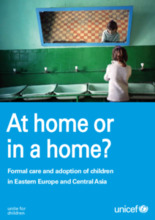Published by UNICEF, the report At Home or in a Home, provides an overview of the major trends and concerns about children in formal care and institutions as well as adoption Central and Eastern Europe and Central Asia. The number of children in residential care in the region is extraordinary – the highest in the world. More than 626,000 children reside in these institutions in the 22 countries or entities that make up Central and Eastern Europe and the Commonwealth of Independent States, CEE/CIS. While there have been real changes in this system, what this report shows is just how difficult reform turned out to be and how slow and uneven progress has been.
Reform has been a partial success. Every country in the CEE/CIS region is – to a varying extent, and with different levels of success – engaged in the reform of the child care system. The vision for reform of the child care system articulates the importance of family based care and de-institutionalization. It recognizes that the reform needs to develop family and child support services to prevent institutionalization, services which were almost non-existent in the past. Statutory services with gatekeeping functions making decisions about services and placements of children must also be reformed. However the reform process has been slow and any progress that has been made is still fragile. The reforms are often not deep enough to have an impact. It is hard to escape the fact that CEE/CIS countries remain reliant on residential care as the default response to risks and vulnerabilities.

